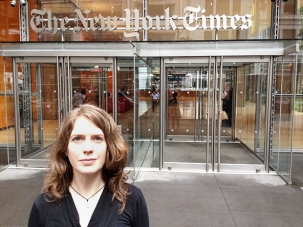Craig Silverman, BA (journ.) 99, award-winning author and founding editor of BuzzFeed Canada, says a fundamental difference from previous transition periods to now has been the means of distribution in media. “In the past you needed a printing press, and TV or radio required investment in machines,” says Silverman. “Now people can publish from a cell phone. This transition that social media has accelerated gets us to the point where having big printing presses does not give you an advantage. Also, the costs of getting in — the barriers — are almost zero.”
Access to news has also altered. “People now get a lot of information from things being shared on social media, whereas in the past they might have sat around and watched the evening newscasts and tuned in to the radio occasionally throughout the day,” Silverman says. “Today there is this constant stream of information. The democratization of distribution and of consumption are fundamental changes that have caused the breakdown of what was a very good business model for newspapers and, to a certain extent, for TV and radio as well.”
There are also the labour costs of newsgathering in an era of “free” news on the internet. “The millennial generation are used to it all being free,” says Gabrial. “This is a major mistake I think many news organizations made: first they had paywalls, then they didn’t have paywalls. They couldn’t quite get their act together and now the horses have left the gate.”
Recent years have also seen mergers and takeovers by mainstream media, such as Rogers, Bell and Shaw in Canada, which have also added to cutbacks and job losses. “If these companies can’t figure out a way to transition to digital and to a better business model, the amount of accountability journalism at the local level will continue to steadily erode and may even disappear for a while until there’s a better replacement,” says Silverman. “Until they figure it out we will keep seeing a huge amount of cuts. The current model is broken and the result is a serious decline in accountability journalism in daily and community newspapers.”
Silverman disputes claims the millennial generation has abandoned traditional media. “Has traditional media been serving them or have they been abandoned by traditional media? It goes both ways,” he says. “There are plenty of millennials who are familiar with The Globe and Mail and The New York Times and see them as having some cur-rency and credibility. But when they engage with them, are they getting what they are looking for and presented in a way that they want?”
He sees this as part of media’s cyclical nature. “There are things you can point to in the history of media — young people being one of them — that never change. Regardless of your age, we all seek out media that give us information that is aligned with the way we see the world,” Silverman says. “When Rolling Stone magazine launched [in 1967], I’m sure that people in their 50s and 60s thought it was the biggest piece of junk they’d ever seen in their lives. But it became a very serious place for journalism.
Today some young people think Rolling Stone is an old and very tired brand.”Silverman points to the demise of the alternative weekly newspapers. “This same thing plays out generation after generation,” he says. “It is part of the cycle: your parents hate your music and your media, and then you become the parent.”
Wide range of skills
There are some encouraging signs. Established media outlets are looking for new ways to stay relevant, such as the La Presse tablet app La Presse+. The daily newspaper pulled the plug on its weekday print edition beginning January 1, 2016, and will eventually discontinue its Saturday print edition. The tablet is now its main platform.
“La Presse was very savvy in conditioning their readers to the future, and they were watched by lots of other organizations,” says Gabrial.
In December, Rogers Media’s Sportsnet showed its faith in Concordia’s Department of Journalism by making a $650,000 donation — the biggest in the history of the program — to help advance sports journalism at the university.
Nonetheless, Concordia’s Department of Journalism has had to readjust for the changing landscape. “We just underwent a complete undergraduate revision, streamlining the program,” Gabrial says. “The old way was to direct people to different areas of interest: broadcast, print, whatever. Now we’re doing away with that to make sure all of our graduating students have all those technical skills along with the journalism skills,” he says.
“This has always been a quandary for journalism programs because we’re not training tech heads. Our job is to train critical-thinking journalists to tell good stories about their world,” Gabrial explains. “We nevertheless make sure those people have the skills. So we’ve done that, and we also require them to have some other academic interest. They cannot graduate with just a journalism degree. They must have another major or a minor in some other area.”



 Brian Gabrial, Chair of Concordia's Department of Journalism
Brian Gabrial, Chair of Concordia's Department of Journalism
 Craig Silverman is founding editor of Buzzfeed Canada.
Craig Silverman is founding editor of Buzzfeed Canada.
 Patti Sonntag, managing editor of the New York Times Syndicate, is Concordia's first Journalist-in-Residence.
Patti Sonntag, managing editor of the New York Times Syndicate, is Concordia's first Journalist-in-Residence.
 Julia Wolfe, seen playing with an Oculus Rift, is the
Julia Wolfe, seen playing with an Oculus Rift, is the